
Memory
Measuring Retention
Psychologists use these three retention measures as evidence for learning
Recall- retrieving information that is not currently in your conscious awareness. Fill-in-the-blank questions
Recognition- Identifying items previously learned. Multiple-Choice questions
Relearning- Learning something more quickly when learned again later. Visiting order of operations in Algebra
Tests of recognition and of time spent relearning demonstrate that we remember more than we can recall (Recognizing the 7 Dawrves names but not recalling them)
Memory Models
Psychologists create memory models. Right now we use an information-processing model that is similarly compared to computer operations.
Encode- to get information into our brains.
Store- retain that information.
Retrieve- later get that information back out.
Most computers process information sequentially, even while alternating between tasks. The human mind processes things simultaneously (sometimes unconsciously) by means of parallel processing.
Another multitrack processing model is connectionism, as it views memories as products of interconnected neural networks. Specific memories arise from particular activation patterns within neural networks. (an employee who prepares for an important presentation and successfully delivers the presentation. The employee's boss gives positive feedback regarding the speech. The employee makes a connection between preparation and success)
Every time you learn something new, your brain develops neural pathways, an example of neuroplasticity, allowing you to learn and memorize new things. To explain memory-forming processes, Richard Atkinson and Richard Shiffrin (1968,2016) proposed a Three-Stage Model.
We record to-be-remembered info as a fleeting sensory memory.
We process info into short-term memory, where we encode it through rehearsal.
Finally, info moves into long-term memory for later retrieval.
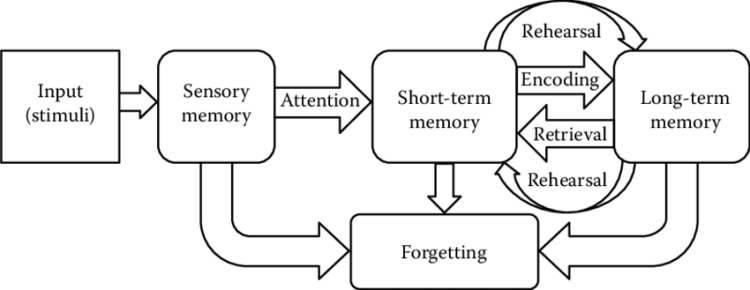 The process of encoding information into long-term memory is vital for successful learning. Rehearsal, or repeating information multiple times, strengthens neural connections and improves memory retention, by the process of neuroplasticity. Elaboration, by making connections or creating mental images, enhances understanding and recall. Mnemonic devices, like acronyms or visual imagery, help associate new information with familiar or easily remembered information. These encoding strategies enhance learning and improve memory retention.
The process of encoding information into long-term memory is vital for successful learning. Rehearsal, or repeating information multiple times, strengthens neural connections and improves memory retention, by the process of neuroplasticity. Elaboration, by making connections or creating mental images, enhances understanding and recall. Mnemonic devices, like acronyms or visual imagery, help associate new information with familiar or easily remembered information. These encoding strategies enhance learning and improve memory retention.
SENSORY MEMORY
Iconic Memory: Momentary sensory memory of visual stimuli. See in image, then you look away to a new image, you see something different your iconic memory is being taken up.
Echoic Memory: Momentary auditory stimuli. Not paying to a speech but still getting the gist of it.
SHORT TERM MEMORY
Sensory to STM
Holds about 7 (plus or minus 2) items for 20 secs
We memorize digits better than letters
However, modern psychologists use the term working memory rather than Short term. Working memory is fluid and better describes the process. Your brain, when it learns new info, it goes through sensory memory and then to working memory, it tries to connect and relate certain things to the memory, and allows synthesis of new material. Then through the process of recall, recognition, and rehearsal, it goes to long-term memory.
WAYS TO ENCODE
Spacing: spread out studying and rehearsal over a long period of time.
Chunking: Organizing items into familiar, manageable units.
Maintenance rehearsal: repeating information.
EBBINGHUAS FORGETTING CURVE
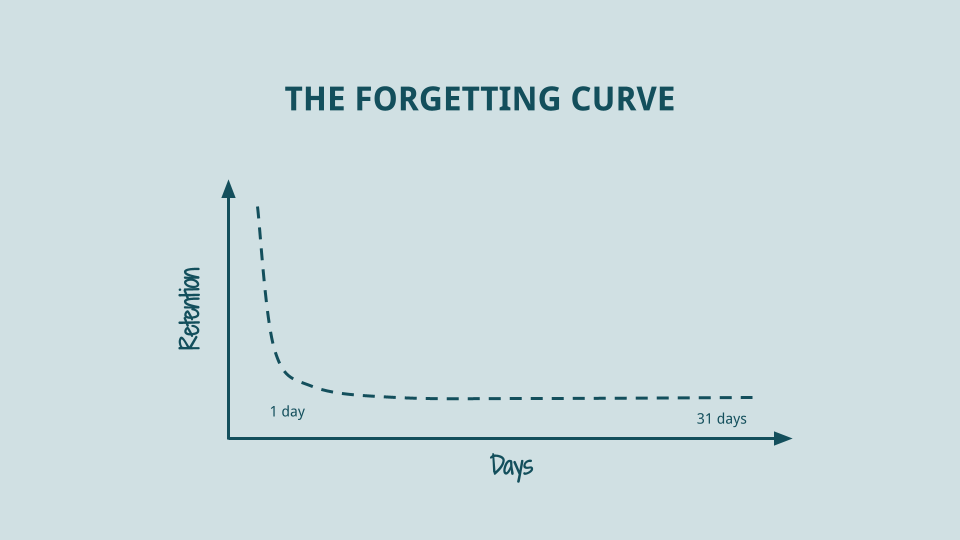
The Ebbinghaus forgetting curve is a concept that explains how information is forgotten over time if it is not reinforced or rehearsed. According to Ebbinghaus, forgetting occurs rapidly in the initial stages after learning, and then levels off over time. This curve illustrates that information is most vulnerable to forgetting shortly after it is encoded into memory. Combat this by spacing, chunking, and maintenance rehearsal.
LONG TERM MEMORY
Long-term memory (LTM) is the storage of information over an extended period. It is where memories are stored for an extended duration, ranging from minutes to a lifetime.
Explicit Memory (Declarative Memory)
Explicit memory is the stored memory of facts. For example, explicit memory is knowing how many continents there are. You can split this up into further categories:
Semantic—the memory of facts, ideas, and concepts. Remembering the FNAF lore
Episodic—memories of personal experiences. Telling a friend about the first time you learned how to crochet
Implicit Memory (Non-Declarative Memory)
Implicit memory is a memory that is remembered unconsciously.
One of the most common forms is procedural memory. Procedural memory is the memory of how to do repetitive everyday tasks. Examples of procedural memories include riding a bike 🚴, tying a shoe 👞, and driving a car 🚗
You can remember implicit memory as the "how to do something" memory.
Overview Graphic of LTM
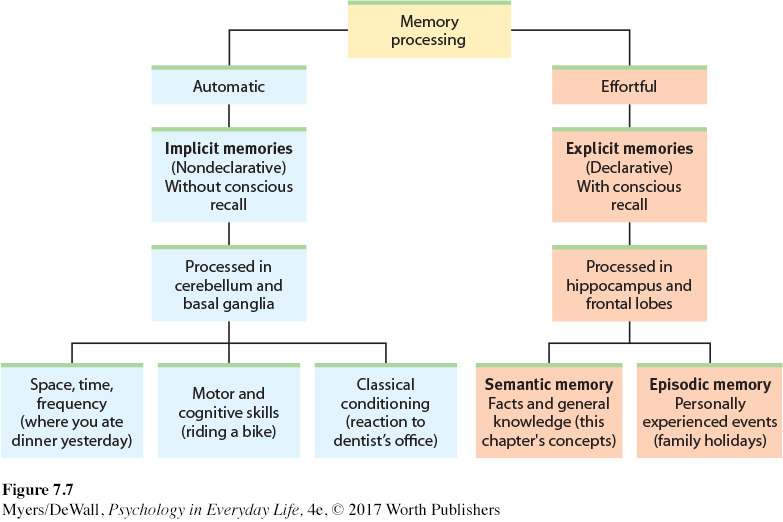 Those who have a photographic memory, or eidetic memory, are rare individuals who are able to use powerful and long-lasting imagery to remember.
Those who have a photographic memory, or eidetic memory, are rare individuals who are able to use powerful and long-lasting imagery to remember.
Organization
There are several ways we organize the information we store:
Hierarchies
The diagram shown above is actually a hierarchy. It starts with really broad information and then splits up into specific classes. Hierarchies help us retrieve information quickly and efficiently.
Schemas
A schema is a concept or framework that helps individuals make sense of information.
Because of schemas, you are more likely to believe the information that supports your belief and ignore information that disagrees with your viewpoint.
Concept
A concept is a mental grouping of events, people, and similar things. For example, if someone tells you to think of a phone, your concept is the type of characteristics you think the phone contains📱 Does it have buttons or is it a touch screen? Is it white, pink, black, etc.? Is it large or small? The characteristics you assign to a “phone” make up your concept of a phone.
Prototype
A prototype is a mental image or the best representative of a certain category.
Think about the concept of a bird. "A robin is a bird 🐦" is said more than "a penguin is a bird🐧 " because the robin more closely resembles our bird prototype.
Whenever you use adjectives like "smaller" or "quicker," you are automatically comparing to a prototype. For example, say you were looking at your favorite type of dog, a German Shepard. When you look at a Yorkie, you may say "Wow, that dog is so small" (compared to your prototype). 🐶
Physical Storage in the Brain
Memory storage in the actual brain has always been a mystery to researchers. Though much of it still remains a mystery, we know that the hippocampus is involved in encoding new memories. Individuals who have damage in the hippocampus might have anterograde amnesia, or the inability to encode new memories, but they can always recall events that are already encoded.
With neurons, something called long-term potentiation happens. This is the strengthening of neural connections between each other. When firings are repeated, the connections are strengthened, causing the memory to be encoded.
Retrieval is the process of recalling information from memory such as feelings, images, and events. This is the last step in our memory process. We retrieve information nonstop, especially when taking an exam.
Retrieval Cues
Retrieval cues help you remember pieces of information! The more cues, the easier it is to remember something
Serial Position Effect
The serial-position effect is how people tend to remember information in a list that is mentioned first or last. The information mentioned in the middle is more forgotten.
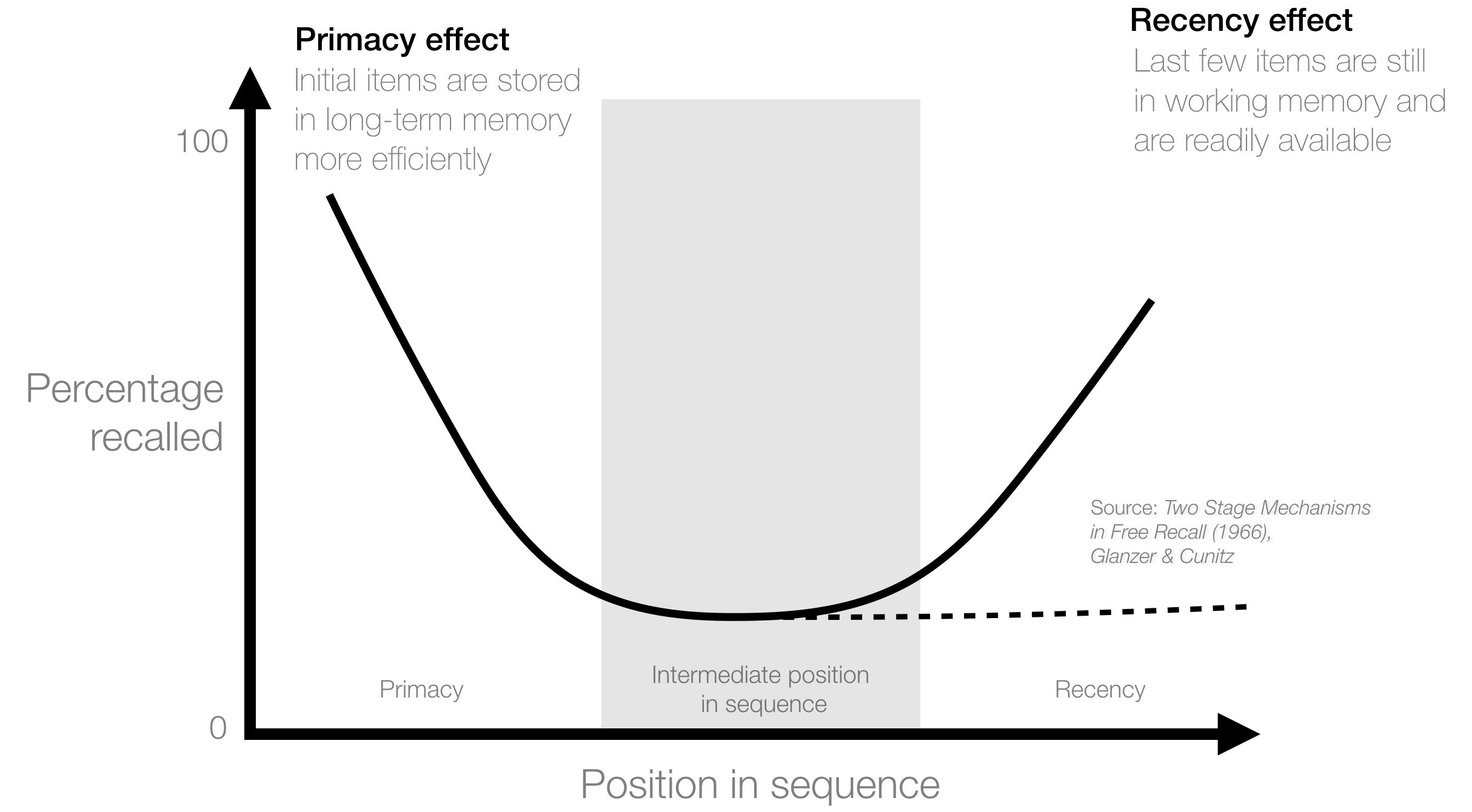
You can also split this up into:
Recency Effect: remembering the last thing that was said
Primacy Effect: remembering the first thing that was said
Mnemonic Device
Mnemonic devices enhance retention and memory. A mnemonic device is a tool that helps you remember an idea or phrase. An example of a mnemonic device would be ROYGBIV, which is used to remember the colors of the rainbow 🌈 (red, orange, yellow, green, blue, indigo, and violet).
Method of Loci
The method of Loci is a mnemonic device in which a person memorizes information by placing each item to be remembered in different spatial locations. For example, let's say you want to remember this shopping list:
Eggs 🥚
Milk 🥛
Cheese 🧀
Potatoes 🥔
Ice cream 🍨
You could use the method of loci to remember your list by placing these different items in different spots in your house and then walking around your house to remember the list. You could place the potato on the couch in your living room and emphasize it by having it lie down on the couch.
Peg Word Mnemonic
This mnemonic device puts numbers and words together to help us memorize a scheme. These often rhyme like "1-SUN, 2-SHOE, 3-TREE, 4-DOOR, and 5-HIVE."
Tip-of-the-tongue Phenomenon
The temporary inability to remember information is called the tip-of-the-tongue phenomenon. It's the thing when you say something's on the "tip of my tongue". This is explained with the semantic network theory. It states that our brain likes to form new memories by connecting its meanings to other existing memories and its meanings. In a sense, our brain creates an interconnected network of memories! So by trying to remember something, you get closer to it by listing its traits.
Priming
Priming is the activation of a memory by association. Hearing one stimulus leads to the activation of another.
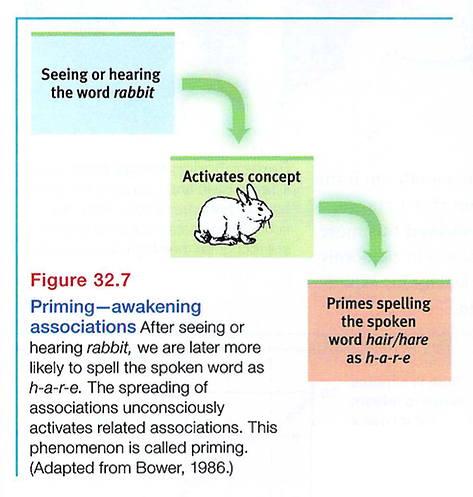
Context-Dependent Memory
Sometimes, what you remember depends on the state or position you are in. Context-dependent memory is specifically remembering information in the same place we encoded it.
For example, if you study at your desk and take the test at your desk as well, you are more likely to do better 💯 Another example is if you're studying and your pencil breaks✏ and you need to go to another room to sharpen it. However, when you leave your room to go to the office, you forget why you even went there. But then when you went back to your desk, you were like "Ohh, I had to sharpen my pencil." 🤦
State-Dependent Memory
State-dependent is how what we learn in one state will be easier to recall in that same state. If someone is drunk and left their keys somewhere, they probably won't remember where when they sober up. However, if they get drunk again, they will remember where they left their keys last time🔑
Mood-Congruent Memory
Mood-congruent memory states that when humans store memories about an event, they don't just store memory, they also store the emotion they felt at that time along with the memory. Therefore, if you are sad you will begin to recall unhappy events. If you're happy, you'll begin to recall other happy events!
Constructive Memory
You may have heard of something called a recovered memory phenomenon. It's when individuals suddenly remember events repressed for many years, often through therapy. While these memories can be true, some researchers like Elizabeth Loftus argue that these may be false recollections of the past. Constructed memories can be false details of real events or a completely made-up event 🤔.
Spacing Effect
The spacing effect says that people learn material easier and more effectively when it is studied several times over a long period of time rather than in a short period of time.
Testing Effect
The testing effect says that you have an enhanced memory after retrieving information, rather than rereading it. If you are studying for a test, you should never just read the content over and over again. Instead, you should actively recall the information. 🧠
Memory Interference
Sometimes, you may forget something because another piece of information gets in the way! 🤦
Retroactive Interference
Retroactive interference is when it becomes harder to recall old information because of learning new information.
An example of this is switching your password from Psych2020 to Psych#2021 and then not being able to recall your old password.️
New information blocks old
Proactive Interference
Proactive interference is when it becomes harder to recall new information because of old information in the past. The old information affects the ability to learn new information.
Using the passwords idea above, you may only remember Psych!2020 and cannot recall your new password, Psych#2021, because of the old.️
Old information blocks new
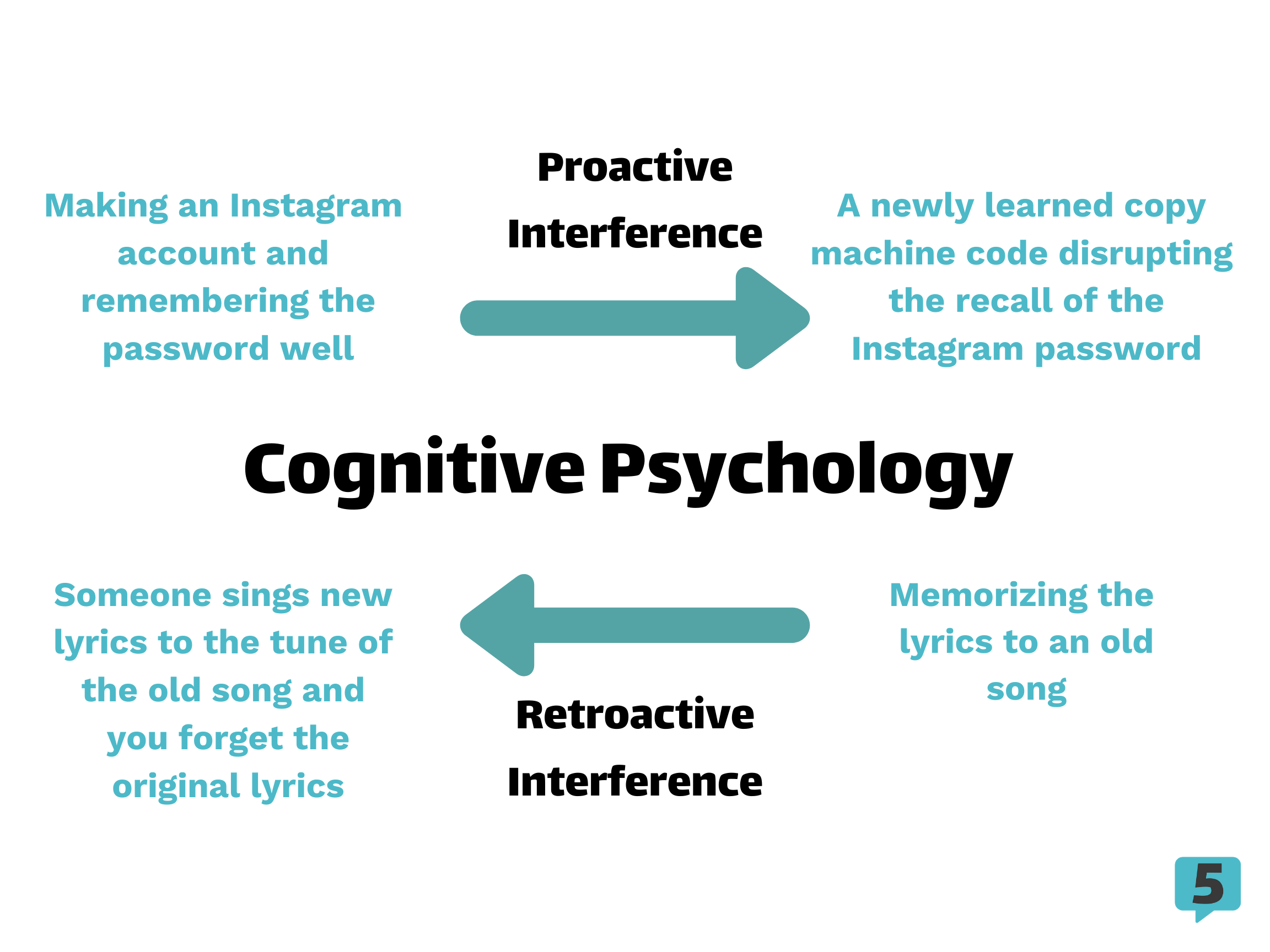
💭In an FRQ about one of these two terms:
Clearly specify what the new information is and what the old information is.
To indicate interference occurring, use the words blocking or preventing. This really shows your understanding of the terms.
Amnesia
Amnesia is another reason why you might not remember something. It is the inability to remember past memories/events and there are different types of amnesias.
Retrograde amnesia
Retrograde amnesia occurs when someone is unable to recall their most recent memories/their general past.
Usually, this sort of amnesia occurs after an emotional or physically traumatic event because there are some details from the event that the victim might not want to remember.
Anterograde amnesia
Anterograde amnesia is when an individual is unable to form new memories. Past memories (long term) can still be recalled, but we have no awareness of it.
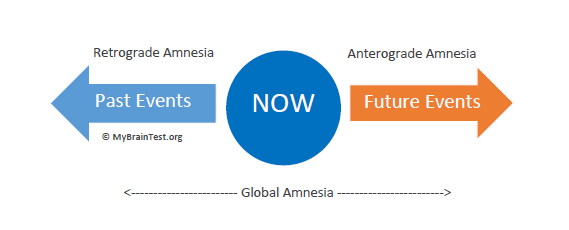 In an FRQ about these terms, be sure to mention brain illness or injuries.
In an FRQ about these terms, be sure to mention brain illness or injuries.
Source amnesia
Source amnesia, also called misattribution error, is the inability to remember how you learned previously acquired information. For example, some people won't remember if they heard a joke they made repeated back to them.
Source amnesia could also refer to not remembering where you heard about/imagined/experienced something. This happens a lot. You know how in movies, songwriters often unintentionally plagiarize and say they've never heard of the other source? This is source amnesia in action!
Deja Vu
Deja vu is a false sense when you feel that you experienced a situation before.
Misinformation Effect
Human memory is not perfect. To illustrate, crime scene eyewitnesses often remember events and the characteristics of people incorrectly, even though they might have witnessed the crime and saw the perpetrator.
The misinformation effect states that a person’s recall of an event is negatively impacted and becomes less accurate due to information after the event. After the event occurs, you might incorporate some inaccurate information about what occurred, influencing attitudes and behaviors.
This was studied by Elizabeth Lotus and led to therapists leading with the question: "What happened?" If a therapist were to ask something specific to the situation and assume something, false information may peep into the person's memory.
Freudian Thinking
Freud believed that we may purposely repress memories and forget them. He called this motivated forgetting. Motivated forgetting could be either conscious or unconscious in order to shy away from unacceptable behaviors or painful memories.
Repression is one of the defense mechanisms in Freud's psychoanalytic theory. Defense mechanisms protect our self-concepts and attempt to minimize the anxiety we feel about a subject.
Hippocampus
The hippocampus is part of the limbic system and in the temporal lobe. The hippocampus is responsible for the formation of memory and processes explicit memories for storage. All memories start at the hippocampus; you can think of it as some sort of "save 💾 button."
After the information gets here, it migrates for storage elsewhere. Some specific facts about the hippocampus:
If there is damage to the left side, you will have trouble remembering verbal information 👄
If there is damage to the right side, you will have trouble recalling visual information 👀
Every region has a different function. For example, there is one region that puts names to faces and another region that engages with mnemonic devices 🌈
Sleep helps your memory consolidation and ensures it is processed.
During deep sleep (NREM-3), memories are processed. Interestingly enough, the brain replays the day's experiences and brings them to your LTM!
Frontal Lobes
Information is sent to the frontal lobes for working memory. Your working memory is similar to STM, but it is the processing of incoming auditory and visual information. It helps make sense of new information and link it to the old information in your long-term memory.
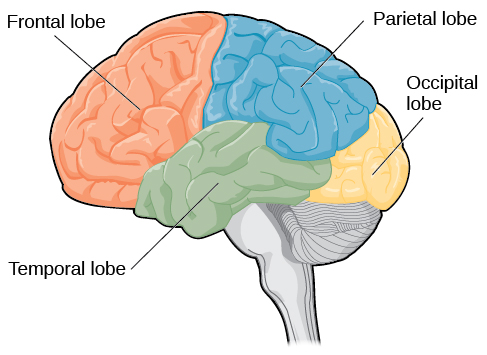
Image Courtesy of Lumen Learning.
⭐️
Fun Fact—You can damage your frontal lobe and hippocampus but still have the ability to lay down implicit memories, like tying your shoe 👞or riding a bike. 🚴
Thalamus
The thalamus is believed to have some role in encoding sensory memory into short-term memory. This short term memory is located mostly in the pre-frontal cortex and temporal lobes.
Cerebellum
The cerebellum stores your implicit memories that are usually formed by classical conditioning and conditioned reflexes. Without a cerebellum, you wouldn't be able to learn from classical conditioning 🐶
Basal Ganglia
You probably rarely hear of this, but it helps form our procedural memories, which is the "how to" type of implicit memory. We really have no idea how we remember things like tying our shoes 👞, but we can thank it all to our basal ganglia.
Amygdala
The amygdala has a lot to do with your emotion (i.e. fear and aggression 😨), but where does it come into play with memory?
Emotions actually affect how well we process a memory. Depending on our emotions, the brain could be fueled more by our hormones and the memory may stick with us longer.
You know that you always remember really exciting moments and really stressful moments, right? These always stick with us because of how strong of an emotion we were feeling at the time. These emotions release stress hormones and provoke the amygdala.
Think of them saying, "Something important is happening! We have to remember this!!" and other parts of the brain will be signaled to aid in the memory process.
No wonder why we remember big moments, like when we lost our loved ones or our first kiss—it just always sticks with us.
Long-term Potentiation
LTP is one of the newer terms in this key topic and it is the strengthening of synapses based on recent activities, producing long-lasting communication between neurons.
For example, if you practice coding using the programming language Python every day and rarely practice coding in Java, you are more likely to remember the Python and forget the Java.
Scientists know that LTP is the physical foundation for memory because:
Drugs 💊 that block long term potentiation interfere with and slow down learning.
If an experiment is done to block LTP, there is a loss of memory and learning 📖 shown.
Neurotransmitters
Neurotransmitters are chemical messengers released by neurons that transmit messages between neurons. The chemical messages are interpreted and received in the neuron’s synapses.
Glutamate and acetylcholine are two neurotransmitters related to memory.
Quick Rundown
Hippocampus --> explicit memories
Frontal Lobes --> working memory
thalamus --> short term memory
Cerebellum --> implicit memories
Basal Ganglia --> implicit procedural memories
Amygdala --> emotion—the stronger the emotion, the more likely we will remember something.
Memory
Measuring Retention
Psychologists use these three retention measures as evidence for learning
Recall- retrieving information that is not currently in your conscious awareness. Fill-in-the-blank questions
Recognition- Identifying items previously learned. Multiple-Choice questions
Relearning- Learning something more quickly when learned again later. Visiting order of operations in Algebra
Tests of recognition and of time spent relearning demonstrate that we remember more than we can recall (Recognizing the 7 Dawrves names but not recalling them)
Memory Models
Psychologists create memory models. Right now we use an information-processing model that is similarly compared to computer operations.
Encode- to get information into our brains.
Store- retain that information.
Retrieve- later get that information back out.
Most computers process information sequentially, even while alternating between tasks. The human mind processes things simultaneously (sometimes unconsciously) by means of parallel processing.
Another multitrack processing model is connectionism, as it views memories as products of interconnected neural networks. Specific memories arise from particular activation patterns within neural networks. (an employee who prepares for an important presentation and successfully delivers the presentation. The employee's boss gives positive feedback regarding the speech. The employee makes a connection between preparation and success)
Every time you learn something new, your brain develops neural pathways, an example of neuroplasticity, allowing you to learn and memorize new things. To explain memory-forming processes, Richard Atkinson and Richard Shiffrin (1968,2016) proposed a Three-Stage Model.
We record to-be-remembered info as a fleeting sensory memory.
We process info into short-term memory, where we encode it through rehearsal.
Finally, info moves into long-term memory for later retrieval.
 The process of encoding information into long-term memory is vital for successful learning. Rehearsal, or repeating information multiple times, strengthens neural connections and improves memory retention, by the process of neuroplasticity. Elaboration, by making connections or creating mental images, enhances understanding and recall. Mnemonic devices, like acronyms or visual imagery, help associate new information with familiar or easily remembered information. These encoding strategies enhance learning and improve memory retention.
The process of encoding information into long-term memory is vital for successful learning. Rehearsal, or repeating information multiple times, strengthens neural connections and improves memory retention, by the process of neuroplasticity. Elaboration, by making connections or creating mental images, enhances understanding and recall. Mnemonic devices, like acronyms or visual imagery, help associate new information with familiar or easily remembered information. These encoding strategies enhance learning and improve memory retention.
SENSORY MEMORY
Iconic Memory: Momentary sensory memory of visual stimuli. See in image, then you look away to a new image, you see something different your iconic memory is being taken up.
Echoic Memory: Momentary auditory stimuli. Not paying to a speech but still getting the gist of it.
SHORT TERM MEMORY
Sensory to STM
Holds about 7 (plus or minus 2) items for 20 secs
We memorize digits better than letters
However, modern psychologists use the term working memory rather than Short term. Working memory is fluid and better describes the process. Your brain, when it learns new info, it goes through sensory memory and then to working memory, it tries to connect and relate certain things to the memory, and allows synthesis of new material. Then through the process of recall, recognition, and rehearsal, it goes to long-term memory.
WAYS TO ENCODE
Spacing: spread out studying and rehearsal over a long period of time.
Chunking: Organizing items into familiar, manageable units.
Maintenance rehearsal: repeating information.
EBBINGHUAS FORGETTING CURVE

The Ebbinghaus forgetting curve is a concept that explains how information is forgotten over time if it is not reinforced or rehearsed. According to Ebbinghaus, forgetting occurs rapidly in the initial stages after learning, and then levels off over time. This curve illustrates that information is most vulnerable to forgetting shortly after it is encoded into memory. Combat this by spacing, chunking, and maintenance rehearsal.
LONG TERM MEMORY
Long-term memory (LTM) is the storage of information over an extended period. It is where memories are stored for an extended duration, ranging from minutes to a lifetime.
Explicit Memory (Declarative Memory)
Explicit memory is the stored memory of facts. For example, explicit memory is knowing how many continents there are. You can split this up into further categories:
Semantic—the memory of facts, ideas, and concepts. Remembering the FNAF lore
Episodic—memories of personal experiences. Telling a friend about the first time you learned how to crochet
Implicit Memory (Non-Declarative Memory)
Implicit memory is a memory that is remembered unconsciously.
One of the most common forms is procedural memory. Procedural memory is the memory of how to do repetitive everyday tasks. Examples of procedural memories include riding a bike 🚴, tying a shoe 👞, and driving a car 🚗
You can remember implicit memory as the "how to do something" memory.
Overview Graphic of LTM
 Those who have a photographic memory, or eidetic memory, are rare individuals who are able to use powerful and long-lasting imagery to remember.
Those who have a photographic memory, or eidetic memory, are rare individuals who are able to use powerful and long-lasting imagery to remember.
Organization
There are several ways we organize the information we store:
Hierarchies
The diagram shown above is actually a hierarchy. It starts with really broad information and then splits up into specific classes. Hierarchies help us retrieve information quickly and efficiently.
Schemas
A schema is a concept or framework that helps individuals make sense of information.
Because of schemas, you are more likely to believe the information that supports your belief and ignore information that disagrees with your viewpoint.
Concept
A concept is a mental grouping of events, people, and similar things. For example, if someone tells you to think of a phone, your concept is the type of characteristics you think the phone contains📱 Does it have buttons or is it a touch screen? Is it white, pink, black, etc.? Is it large or small? The characteristics you assign to a “phone” make up your concept of a phone.
Prototype
A prototype is a mental image or the best representative of a certain category.
Think about the concept of a bird. "A robin is a bird 🐦" is said more than "a penguin is a bird🐧 " because the robin more closely resembles our bird prototype.
Whenever you use adjectives like "smaller" or "quicker," you are automatically comparing to a prototype. For example, say you were looking at your favorite type of dog, a German Shepard. When you look at a Yorkie, you may say "Wow, that dog is so small" (compared to your prototype). 🐶
Physical Storage in the Brain
Memory storage in the actual brain has always been a mystery to researchers. Though much of it still remains a mystery, we know that the hippocampus is involved in encoding new memories. Individuals who have damage in the hippocampus might have anterograde amnesia, or the inability to encode new memories, but they can always recall events that are already encoded.
With neurons, something called long-term potentiation happens. This is the strengthening of neural connections between each other. When firings are repeated, the connections are strengthened, causing the memory to be encoded.
Retrieval is the process of recalling information from memory such as feelings, images, and events. This is the last step in our memory process. We retrieve information nonstop, especially when taking an exam.
Retrieval Cues
Retrieval cues help you remember pieces of information! The more cues, the easier it is to remember something
Serial Position Effect
The serial-position effect is how people tend to remember information in a list that is mentioned first or last. The information mentioned in the middle is more forgotten.

You can also split this up into:
Recency Effect: remembering the last thing that was said
Primacy Effect: remembering the first thing that was said
Mnemonic Device
Mnemonic devices enhance retention and memory. A mnemonic device is a tool that helps you remember an idea or phrase. An example of a mnemonic device would be ROYGBIV, which is used to remember the colors of the rainbow 🌈 (red, orange, yellow, green, blue, indigo, and violet).
Method of Loci
The method of Loci is a mnemonic device in which a person memorizes information by placing each item to be remembered in different spatial locations. For example, let's say you want to remember this shopping list:
Eggs 🥚
Milk 🥛
Cheese 🧀
Potatoes 🥔
Ice cream 🍨
You could use the method of loci to remember your list by placing these different items in different spots in your house and then walking around your house to remember the list. You could place the potato on the couch in your living room and emphasize it by having it lie down on the couch.
Peg Word Mnemonic
This mnemonic device puts numbers and words together to help us memorize a scheme. These often rhyme like "1-SUN, 2-SHOE, 3-TREE, 4-DOOR, and 5-HIVE."
Tip-of-the-tongue Phenomenon
The temporary inability to remember information is called the tip-of-the-tongue phenomenon. It's the thing when you say something's on the "tip of my tongue". This is explained with the semantic network theory. It states that our brain likes to form new memories by connecting its meanings to other existing memories and its meanings. In a sense, our brain creates an interconnected network of memories! So by trying to remember something, you get closer to it by listing its traits.
Priming
Priming is the activation of a memory by association. Hearing one stimulus leads to the activation of another.

Context-Dependent Memory
Sometimes, what you remember depends on the state or position you are in. Context-dependent memory is specifically remembering information in the same place we encoded it.
For example, if you study at your desk and take the test at your desk as well, you are more likely to do better 💯 Another example is if you're studying and your pencil breaks✏ and you need to go to another room to sharpen it. However, when you leave your room to go to the office, you forget why you even went there. But then when you went back to your desk, you were like "Ohh, I had to sharpen my pencil." 🤦
State-Dependent Memory
State-dependent is how what we learn in one state will be easier to recall in that same state. If someone is drunk and left their keys somewhere, they probably won't remember where when they sober up. However, if they get drunk again, they will remember where they left their keys last time🔑
Mood-Congruent Memory
Mood-congruent memory states that when humans store memories about an event, they don't just store memory, they also store the emotion they felt at that time along with the memory. Therefore, if you are sad you will begin to recall unhappy events. If you're happy, you'll begin to recall other happy events!
Constructive Memory
You may have heard of something called a recovered memory phenomenon. It's when individuals suddenly remember events repressed for many years, often through therapy. While these memories can be true, some researchers like Elizabeth Loftus argue that these may be false recollections of the past. Constructed memories can be false details of real events or a completely made-up event 🤔.
Spacing Effect
The spacing effect says that people learn material easier and more effectively when it is studied several times over a long period of time rather than in a short period of time.
Testing Effect
The testing effect says that you have an enhanced memory after retrieving information, rather than rereading it. If you are studying for a test, you should never just read the content over and over again. Instead, you should actively recall the information. 🧠
Memory Interference
Sometimes, you may forget something because another piece of information gets in the way! 🤦
Retroactive Interference
Retroactive interference is when it becomes harder to recall old information because of learning new information.
An example of this is switching your password from Psych2020 to Psych#2021 and then not being able to recall your old password.️
New information blocks old
Proactive Interference
Proactive interference is when it becomes harder to recall new information because of old information in the past. The old information affects the ability to learn new information.
Using the passwords idea above, you may only remember Psych!2020 and cannot recall your new password, Psych#2021, because of the old.️
Old information blocks new

💭In an FRQ about one of these two terms:
Clearly specify what the new information is and what the old information is.
To indicate interference occurring, use the words blocking or preventing. This really shows your understanding of the terms.
Amnesia
Amnesia is another reason why you might not remember something. It is the inability to remember past memories/events and there are different types of amnesias.
Retrograde amnesia
Retrograde amnesia occurs when someone is unable to recall their most recent memories/their general past.
Usually, this sort of amnesia occurs after an emotional or physically traumatic event because there are some details from the event that the victim might not want to remember.
Anterograde amnesia
Anterograde amnesia is when an individual is unable to form new memories. Past memories (long term) can still be recalled, but we have no awareness of it.
 In an FRQ about these terms, be sure to mention brain illness or injuries.
In an FRQ about these terms, be sure to mention brain illness or injuries.
Source amnesia
Source amnesia, also called misattribution error, is the inability to remember how you learned previously acquired information. For example, some people won't remember if they heard a joke they made repeated back to them.
Source amnesia could also refer to not remembering where you heard about/imagined/experienced something. This happens a lot. You know how in movies, songwriters often unintentionally plagiarize and say they've never heard of the other source? This is source amnesia in action!
Deja Vu
Deja vu is a false sense when you feel that you experienced a situation before.
Misinformation Effect
Human memory is not perfect. To illustrate, crime scene eyewitnesses often remember events and the characteristics of people incorrectly, even though they might have witnessed the crime and saw the perpetrator.
The misinformation effect states that a person’s recall of an event is negatively impacted and becomes less accurate due to information after the event. After the event occurs, you might incorporate some inaccurate information about what occurred, influencing attitudes and behaviors.
This was studied by Elizabeth Lotus and led to therapists leading with the question: "What happened?" If a therapist were to ask something specific to the situation and assume something, false information may peep into the person's memory.
Freudian Thinking
Freud believed that we may purposely repress memories and forget them. He called this motivated forgetting. Motivated forgetting could be either conscious or unconscious in order to shy away from unacceptable behaviors or painful memories.
Repression is one of the defense mechanisms in Freud's psychoanalytic theory. Defense mechanisms protect our self-concepts and attempt to minimize the anxiety we feel about a subject.
Hippocampus
The hippocampus is part of the limbic system and in the temporal lobe. The hippocampus is responsible for the formation of memory and processes explicit memories for storage. All memories start at the hippocampus; you can think of it as some sort of "save 💾 button."
After the information gets here, it migrates for storage elsewhere. Some specific facts about the hippocampus:
If there is damage to the left side, you will have trouble remembering verbal information 👄
If there is damage to the right side, you will have trouble recalling visual information 👀
Every region has a different function. For example, there is one region that puts names to faces and another region that engages with mnemonic devices 🌈
Sleep helps your memory consolidation and ensures it is processed.
During deep sleep (NREM-3), memories are processed. Interestingly enough, the brain replays the day's experiences and brings them to your LTM!
Frontal Lobes
Information is sent to the frontal lobes for working memory. Your working memory is similar to STM, but it is the processing of incoming auditory and visual information. It helps make sense of new information and link it to the old information in your long-term memory.

Image Courtesy of Lumen Learning.
⭐️
Fun Fact—You can damage your frontal lobe and hippocampus but still have the ability to lay down implicit memories, like tying your shoe 👞or riding a bike. 🚴
Thalamus
The thalamus is believed to have some role in encoding sensory memory into short-term memory. This short term memory is located mostly in the pre-frontal cortex and temporal lobes.
Cerebellum
The cerebellum stores your implicit memories that are usually formed by classical conditioning and conditioned reflexes. Without a cerebellum, you wouldn't be able to learn from classical conditioning 🐶
Basal Ganglia
You probably rarely hear of this, but it helps form our procedural memories, which is the "how to" type of implicit memory. We really have no idea how we remember things like tying our shoes 👞, but we can thank it all to our basal ganglia.
Amygdala
The amygdala has a lot to do with your emotion (i.e. fear and aggression 😨), but where does it come into play with memory?
Emotions actually affect how well we process a memory. Depending on our emotions, the brain could be fueled more by our hormones and the memory may stick with us longer.
You know that you always remember really exciting moments and really stressful moments, right? These always stick with us because of how strong of an emotion we were feeling at the time. These emotions release stress hormones and provoke the amygdala.
Think of them saying, "Something important is happening! We have to remember this!!" and other parts of the brain will be signaled to aid in the memory process.
No wonder why we remember big moments, like when we lost our loved ones or our first kiss—it just always sticks with us.
Long-term Potentiation
LTP is one of the newer terms in this key topic and it is the strengthening of synapses based on recent activities, producing long-lasting communication between neurons.
For example, if you practice coding using the programming language Python every day and rarely practice coding in Java, you are more likely to remember the Python and forget the Java.
Scientists know that LTP is the physical foundation for memory because:
Drugs 💊 that block long term potentiation interfere with and slow down learning.
If an experiment is done to block LTP, there is a loss of memory and learning 📖 shown.
Neurotransmitters
Neurotransmitters are chemical messengers released by neurons that transmit messages between neurons. The chemical messages are interpreted and received in the neuron’s synapses.
Glutamate and acetylcholine are two neurotransmitters related to memory.
Quick Rundown
Hippocampus --> explicit memories
Frontal Lobes --> working memory
thalamus --> short term memory
Cerebellum --> implicit memories
Basal Ganglia --> implicit procedural memories
Amygdala --> emotion—the stronger the emotion, the more likely we will remember something.
 Knowt
Knowt
